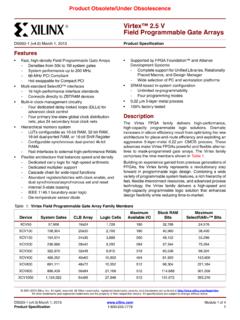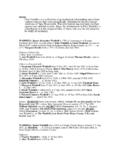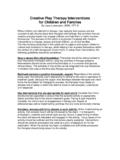Transcription of Xilinx DS060 Spartan and Spartan-XL FPGA …
1 DS060 ( ) March 1, Specification 1998-2013 Xilinx , Inc. All rights reserved. All Xilinx trademarks, registered trademarks, patents, and disclaimers are as listed at All other trademarks and registered trademarks are the property of their respective owners. All specifications are subject to change without Obsolete/Under ObsolescenceIntroductionThe Spartan and the Spartan -XL FPGA families are ahigh-volume production FPGA solution that delivers all thekey requirements for ASIC replacement up to 40,000 requirements include high performance, on-chipRAM, core solutions and prices that, in high volume,approach and in many cases are equivalent to mask pro-grammed ASIC streamlining the Spartan series feature set, leveragingadvanced process technologies and focusing on total costmanagement, the Spartan series delivers the key featuresrequired by ASIC and other high-volume logic users whileavoiding the initial cost, long development cycles and inher-ent risk of conventional ASICs.
2 The Spartan and Spar-tan-XL families in the Spartan series have ten members, asshown in Ta b l e FPGA FeaturesNote: The Spartan series devices described in this datasheet include the 5V Spartan family and the family. See the separate data sheets for moreadvanced members for the Spartan Series. First ASIC replacement FPGA for high-volume production with on-chip RAM Density up to 1862 logic cells or 40,000 system gates Streamlined feature set based on XC4000 architecture System performance beyond 80 MHz Broad set of AllianceCORE and LogiCORE predefined solutions available Unlimited reprogrammability Low cost System level features-Available in both 5V and versions-On-chip SelectRAM memory-Fully PCI compliant-Full readback capability for program verification and internal node observability-Dedicated high-speed carry logic-Internal 3-state bus capability-Eight global low-skew clock or signal networks-IEEE Boundary Scan logic -Low cost plastic packages available in all densities-Footprint compatibility in common packages Fully supported by powerful Xilinx ISE Classics development system-Fully automatic mapping.
3 Placement and routingAdditional Spartan -XL Family Features supply for low power with 5V tolerant I/Os Power down input Higher performance Faster carry logic More flexible high-speed clock network Latch capability in Configurable Logic Blocks Input fast capture latch Optional MUX or 2-input function generator on outputs 12 mA or 24 mA output drive 5V and PCI compliant Enhanced Boundary Scan Express Mode configuration 0 Spartan and Spartan -XL FPGA families Data SheetDS060 ( ) March 1, 201300 Product SpecificationRTa b l e 1 : Spartan and Spartan -XL Field Programmable Gate ArraysDeviceLogicCellsMax System GatesTypical Gate Range(Logic and RAM)(1)CLBM atrixTo ta lCLBsNo. of Flip-flopsMax. Avail. User I/OTo ta l Distributed RAM BitsXCS05 and XCS05XL2385,0002,000-5,00010 x 10100360773,200 XCS10 and XCS10XL46610,0003,000-10,00014 x 141966161126,272 XCS20 and XCS20XL95020,0007,000-20,00020 x 204001,12016012,800 XCS30 and XCS30XL136830,00010,000-30,00024 x 245761,53619218,432 XCS40 and XCS40XL186240,00013,000-40,00028 x 287842,016205(2)25,088 Notes.
4 Values of Typical Gate Range include 20-30% of CLBs used as provided 224 max I/O in CS280 package discontinued by and Spartan -XL FPGA families Data ( ) March 1, 2013 Product SpecificationRProduct Obsolete/Under ObsolescenceGeneral OverviewSpartan series FPGAs are implemented with a regular, flex-ible, programmable architecture of Configurable LogicBlocks (CLBs), interconnected by a powerful hierarchy ofversatile routing resources (routing channels), and sur-rounded by a perimeter of programmable Input/OutputBlocks (IOBs), as seen in Figure 1. They have generousrouting resources to accommodate the most complex inter-connect patterns. The devices are customized by loading configuration datainto internal static memory cells. Re-programming is possi-ble an unlimited number of times. The values stored in thesememory cells determine the logic functions and intercon-nections implemented in the FPGA.
5 The FPGA can eitheractively read its configuration data from an external serialPROM (Master Serial mode), or the configuration data canbe written into the FPGA from an external device (SlaveSerial mode). Spartan series FPGAs can be used where hardware mustbe adapted to different user applications. FPGAs are idealfor shortening design and development cycles, and alsooffer a cost-effective solution for production rates wellbeyond 50,000 systems per month. Figure 1: Basic FPGA Block DiagramCLBB-SCANCLBCLBCLBCLBCLBR outing ChannelsVersaRing Routing ChannelsCLBCLBCLBCLBCLBCLBCLBCLBCLBCLBIO BIOBIOBIOBIOBIOBIOBIOBIOBIOBIOBIOBIOBIOB IOBIOBIOBIOBIOBIOBIOBIOBIOBIOBIOBIOBIOBI OBIOBIOBIOBIOBRDBKSTART-UPOSCDS060_01_08 1100 Spartan and Spartan -XL FPGA families Data SheetDS060 ( ) March 1, SpecificationRProduct Obsolete/Under ObsolescenceSpartan and Spartan -XL devices provide system clockrates exceeding 80 MHz and internal performance inexcess of 150 MHz.
6 In addition to the conventional benefitof high volume programmable logic solutions, Spartanseries FPGAs also offer on-chip edge-triggered single-portand dual-port RAM, clock enables on all flip-flops, fast carrylogic, and many other Spartan /XL families leverage the highly successfulXC4000 architecture with many of that family s features andbenefits. Technology advancements have been derivedfrom the XC4000 XLA process Functional Description The Spartan series uses a standard FPGA structure asshown in Figure 1, page 2. The FPGA consists of an arrayof configurable logic blocks (CLBs) placed in a matrix ofrouting channels. The input and output of signals isachieved through a set of input/output blocks (IOBs) forminga ring around the CLBs and routing channels. CLBs provide the functional elements for implementing the user s logic. IOBs provide the interface between the package pins and internal signal lines.
7 Routing channels provide paths to interconnect the inputs and outputs of the CLBs and functionality of each circuit block is customized duringconfiguration by programming internal static memory values stored in these memory cells determine thelogic functions and interconnections implemented in Logic Blocks (CLBs)The CLBs are used to implement most of the logic in anFPGA. The principal CLB elements are shown in the simpli-fied block diagram in Figure 2. There are three look-uptables (LUT) which are used as logic function generators,two flip-flops and two groups of signal steering are also some more advanced features provided bythe CLB which will be covered in the Advanced FeaturesDescription, page GeneratorsTwo 16 x 1 memory look-up tables (F-LUT and G-LUT) areused to implement 4-input function generators, each offer-ing unrestricted logic implementation of any Boolean func-tion of up to four independent input signals (F1 to F4 or G1to G4).
8 Using memory look-up tables the propagation delayis independent of the function third 3-input function generator (H-LUT) can implementany Boolean function of its three inputs. Two of these inputsare controlled by programmable multiplexers (see box "A" ofFigure 2). These inputs can come from the F-LUT or G-LUToutputs or from CLB inputs. The third input always comesfrom a CLB input. The CLB can, therefore, implement cer-tain functions of up to nine inputs, like parity checking. Thethree LUTs in the CLB can also be combined to do any arbi-trarily defined Boolean function of five and Spartan -XL FPGA families Data ( ) March 1, 2013 Product SpecificationRProduct Obsolete/Under ObsolescenceA CLB can implement any of the following functions: Any function of up to four variables, plus any second function of up to four unrelated variables, plus any third function of up to three unrelated variablesNote: When three separate functions are generated, one of the function outputs must be captured in a flip-flop internal to the CLB.
9 Only two unregistered function generator outputs are available from the CLB. Any single function of five variables Any function of four variables together with some functions of six variables Some functions of up to nine wide functions in a single block reduces boththe number of blocks required and the delay in the signalpath, achieving both increased capacity and speed. The versatility of the CLB function generators significantlyimproves system speed. In addition, the design-softwaretools can deal with each function generator flexibility improves cell usage. Flip-Flops Each CLB contains two flip-flops that can be used to regis-ter (store) the function generator outputs. The flip-flops andfunction generators can also be used independently (seeFigure 2). The CLB input DIN can be used as a direct inputto either of the two flip-flops. H1 can also drive eitherflip-flop via the H-LUT with a slight additional two flip-flops have common clock (CK), clock enable(EC) and set/reset (SR) inputs.
10 Internally both flip-flops arealso controlled by a global initialization signal (GSR) whichis described in detail in Global Signals: GSR and GTS,page 20. Latches ( Spartan -XL Family Only)The Spartan -XL family CLB storage elements can also beconfigured as latches. The two latches have common clock(K) and clock enable (EC) inputs. Functionality of the stor-age element is described in Ta b l e 2: Spartan /XL Simplified CLB Logic Diagram (some features not shown)G4GH1FG4G3G3G2G2G1 DYQYXSRCKECQG1 SRH1 DINGHL ogicFunctionofG1-G4 LogicFunctionofF-G-H1 Multiplexer Controlledby Configuration ProgramG-LUTF4F4F3F3F2F2F1F1 KECGL ogicFunctionofF1-F4F-LUTH-LUTABDXQSRCKEC QDS060_02_0506 01 Spartan and Spartan -XL FPGA families Data SheetDS060 ( ) March 1, SpecificationRProduct Obsolete/Under Input Each flip-flop can be triggered on either the rising or fallingclock edge. The CLB clock line is shared by both , the clock is individually invertible for each flip-flop(see CK path in Figure 3).
















